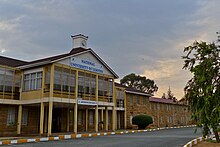National University of Lesotho
 |
|
|
Former names
|
Pius XII Catholic University College, University of Basutoland, Bechuanaland Protectorate and Swaziland, University of Botswana, Lesotho and Swaziland |
|---|---|
| Motto | Nete ke Thebe (Truth is a Shield) |
| Type | Public |
| Established | 1945 |
| President | Chancellor King Letsie III |
| Students | 2,013 |
| Location | Roma, Lesotho |
| Campus | 198 acres (80 hectares) |
| Website | www.nul.ls |
The National University of Lesotho is in Roma, some 34 kilometers southeast of Maseru, the capital of Lesotho. The Roma valley is broad and is surrounded by a barrier of rugged mountains which provides magnificent scenery. The university enjoys a temperate climate with four distinct seasons. The governing body of the University is the Council and academic policy is in the hands of Senate, both Council and Senate being established by the Act.
Faculties and departments:
The origins of the National University of Lesotho date to April 8, 1945, when a Catholic University College was founded at Roma by the Roman Catholic Hierarchy of Southern Africa. The establishment of this college was a realisation of a decision taken in 1938 by the Synod of Catholic Bishops in South Africa to provide African Catholic students with post-matriculation and religious guidance. The Catholic University College was founded in an isolated valley 34 kilometers from Maseru in a temporary primary school building at Roma Mission.
In 1946 the college moved from the temporary building to the present site. This was made possible by the allocation of some 52 acres (210,000 m²) of land to the college by the paramount chief.
In 1950, the Catholic University College was ceded to the Congregation of Oblates of Mary Immaculate. Pius XII College prepared its students for the external degrees of the University of South Africa (UNISA). By September 27, 1954, having satisfied itself that Pius XII College was an academically viable institution, UNISA agreed to enter into a formal agreement — thereby granting "Associate College" status. This development was of major significance to the Roma intellectual community as it entailed a degree of "decentralisation" in specific areas on the part of UNISA, e.g., Pius Xil College assumed greater responsibility for tuition and examinations. Indeed, between 1954 and 1960 the academic and physical growth of the college accelerated. Fathers Beaule, Quirion, and Guilbeault (then rector) participated actively in its early development.
In the early 60s the college experienced academic and financial difficulties. UNISA unilaterally decided to redefine its relationship with the college and, finally, the main benefactor directed its resources elsewhere.
The denominational character of the Catholic University College made it difficult for international organizations, agencies, and foundations to fund such an institution of higher learning. Despite these problems, advice received from John Lockwood and James Cook, both vice-chancellors of British universities, discouraged the college authorities from seeking an affiliation with either the University of London or any other overseas university. As early as 1952, attempts by the college to secure a special relationship with the University of London, through the Inter-University Council for Higher Education Overseas (commonly referred to as the I-VC) had been unsuccessful.
...
Wikipedia
